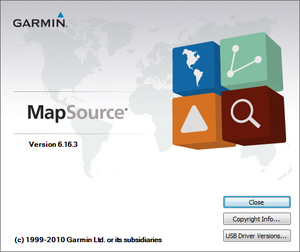 I started using Garmin’s MapSource when I got that first GPS back in 1999. That Garmin GPS III did not support routing in any meaningful sense so I don’t know if contemporary versions of MapSource did or not. For me and the GPS III, MapSource served only to load the unit with maps and points-of-interest covering my immediate needs. The limited capacity of the GPS III meant I had to do this every day or so. Occasionally less, Occasionally more. With the acquisition of the Garmin Quest in 2006, I started using MapSource to download routes.
I started using Garmin’s MapSource when I got that first GPS back in 1999. That Garmin GPS III did not support routing in any meaningful sense so I don’t know if contemporary versions of MapSource did or not. For me and the GPS III, MapSource served only to load the unit with maps and points-of-interest covering my immediate needs. The limited capacity of the GPS III meant I had to do this every day or so. Occasionally less, Occasionally more. With the acquisition of the Garmin Quest in 2006, I started using MapSource to download routes.
I also used it — briefly — to create routes. As I admitted in My Apps Chapter 2, exactly when and why DeLorme’s Street Atlas became my router of choice is lost to history. It seems I first used it sometime in 2001 but I can’t say whether or not it was an instant hit. Whatever the history, by 2006 I was a pretty solid fan of Street Atlas’ user interface. But I needed to use MapSource to get data to and from the Quest and, since it apparently contained some very capable route management features, I tried dumping DeLorme and switching completely to Garmin. It didn’t work.
I’ve gone through enough software updates in my life to understand that there is always some resistance to change and that learning something new requires some effort. I tried telling myself that I disliked the MapSource interface only because it was different. This was certainly true to a certain extent. Some things only seemed more difficult with MapSource because I was unfamiliar with it. But some things, such as moving a route’s endpoints, I believe really were more difficult. And there were a few things that simply couldn’t be done with MapSource. An example of this is the simultaneous display of multiple routes which I’d grown used to with Street Atlas and which just wasn’t possible with MapSource. So I went back to plotting routes with Street Atlas then exporting them to a GPX file which was easily imported to MapSource for transfer to the Quest. The exporting and importing was very simple and quick. It was also hazardous.
The map data used by the two products was not identical. A plotted point that was right in the center of a DeLorme road might miss the Garmin version of that road by several feet. That wasn’t a big deal most of the time but sometimes it was a real disaster. The clearest example is a point in the west bound lane of a divided highway for DeLorme that shows up in the east bound lane for Garmin. When Garmin GPS receivers announce the next action, they usually provide a hint of the following one as well. Taking a route directly from DeLorme to Garmin once caused the Quest to tell me “In 500 feet make a U-turn then make a U-turn.” Around cloverleaves and other complex interchanges, a route could really get mangled.
The “solution” was to tweak the route in MapSource to match Garmin’s maps before transferring it to the GPS unit. Yes, it’s a pain but it’s a small pain and one I’ve decided I’m willing to endure in order to use Street Atlas for route creation. I know that not everyone would agree.
Regarding the maps themselves, I’ve discovered plenty of errors in both DeLorme and Garmin. Same with Google Maps which are starting to find their way into my life. I am not an authority and have no opinion on which has the most or worst errors. The bottom line is that I’ll be dealing with Garmin Maps and their support software as long as I’m dealing with Garmin GPS hardware and I’ll be doing that until something better for solo road-tripping comes along.
